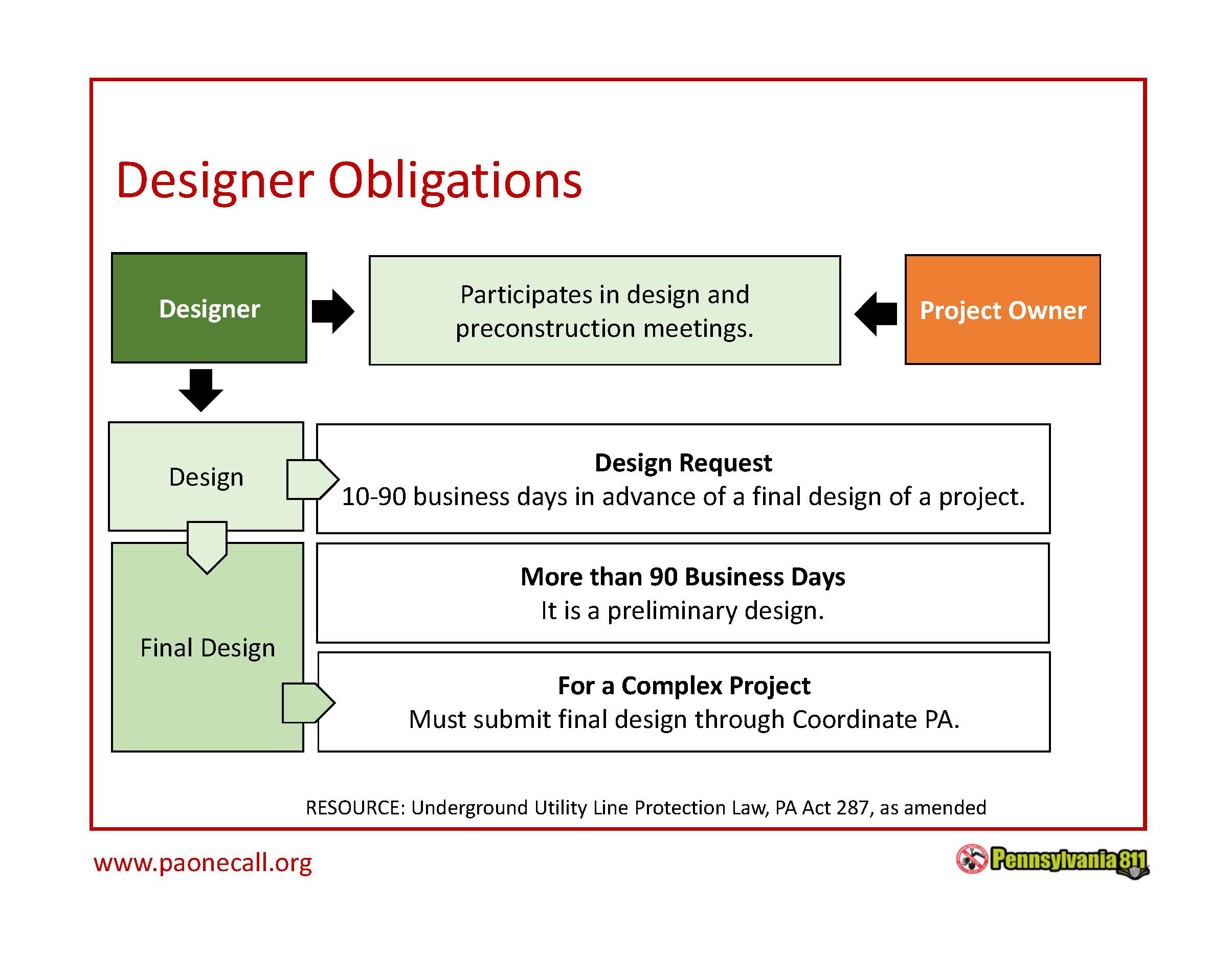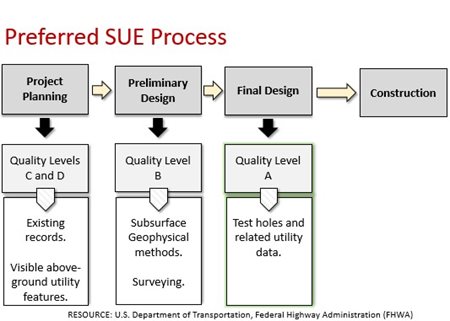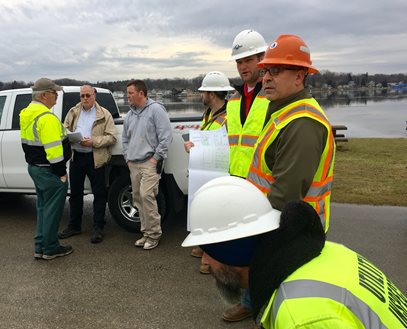Project Owners and Designers
Each designer preparing a drawing requiring excavation or demolition work shall place a notification with the Pennsylvania One Call System, which allows the designer to plan the new work around the existing facilities. Pennsylvania Underground Utility Line Protection (UULP) law. PA Act 287 of 1974, as amended by Act 50 of 2017.
The information provided by the designer on the notification should cover the entire scope of the plan or development with enough detail to allow the facility owners to provide the approximate locations of their lines in the proposed work area. The two types of design notifications are:
- Preliminary design: Those requesting line and facility information more than 90 business days before the final design is to be completed shall state in their requirements the request is a preliminary design
- Final design: Design notifications which are not less than 10, nor more than 90 business days in advance of the final design
The date of the most recent final design notification should never be more than 90 business days prior to the project bid date or date of construction in absence of a bid. 
A project owner is any person who engages an excavator for construction or any other project which requires excavation or demolition work.
The project owner is in the unique position to have the greatest impact by applying damage prevention measures, throughout the design and preconstruction phases, even extending beyond once excavation begins, because they have control of the finances, the scope of project, and the terms in the contract. Good communication among the project owner, designer, excavator and involved facility owners is necessary to produce the most accurate construction drawings possible.
Online Tools for Project Owners and Designers
Project Owner and Designer Responsibilities
In many instances engineering and construction drawings are prepared far in advance of the bid date or the start of construction, or last minute project owner/designer adjustments may result in changes to the proposed excavation area. Preliminary design notifications should be created.
The information provided by you on the notification should cover the entire scope of the plan or development with enough detail to allow the facility owners to provide the locations of their lines in the proposed work area.
Requesting line and facility information more than 90 business days before the final design is to be completed shall state in their requirements the request is a preliminary design.
- You are required to send plans to the involved facility owners for mark-up when requested
- Pennsylvania One Call System can assist through its Coordinate PA application, where plans and responses can be shared electronically
- Once the facility owners have responded, you can add their facility information to the drawing before the final design is approved
- You are also required to add the one call serial number and 1-800-242-1776 or 8-1-1 to the plan before you forward it to the involved facility owners
During the planning phase of the project, all available information is gathered from facility owners/operators.
- This includes maps of existing, abandoned, and out-of-service facilities; cathodic protection and grounding systems, as-builts of facilities in the area if the maps are not current; proposed project designs; and schedules of other work in the area
- This information is gathered for the pupose of route selection and preliminary neighborhood impacts and as part of the process of impact analysis when evaluating different design possibilties
- Gathering information should include a review of the site for above ground indications of underground facilities (e.g. permanent signs or markers, manhole covers, vent pipes, pad-mounted devices, riser poles, power and communication pedestals, and valve covers)
As a designer, you should consult with the project owner. During the planning phase of the project, existing facilities are shown on preliminary design plans. The planning documents include possible routes for the project together with known underground facility information.The various facility owners/operators were given the opportunity to provide appropriate feedback.
During the design phase of the project, the underground facility information from the planning phase is shown on the plans. The designer and the project owner should discuss ways to reduce hazards, simplify coordination and minimize the cost to produce the final project.
The project owner is in the best position to influence damage prevention measures applied in the design and preconstruction phases, as well as once excavation begins, as they control the finances, scope of project, and terms in the contract to populate future projects to be successful at improving project quality, eliminating potential conflicts in advance of construction, and reducing damages to existing infrastructure.
For a project owner to make these decisions, a designer must disclose and discuss the planning document findings.
It is the duty of project owners to utilize and pay for Subsurface Utility Engineering in accordance to PA Act 287, as amended. It is the project owner who initiates design projects that will require excavation or demolition. The use of SUE or other similar techniques is required on large or complex projects costing $400,000 or more. SUE provides a way to accurately identify the quality of subsurface utility information. The highest level of SUE, Level A, provides precise location information permitting the designer to avoid conflicts with the underground facilities, where possible.

For new construction and where practicable in the opinion of the project owner, color-coded permanent markers must be installed to indicate the type and location of all laterals installed by the project owner. These markers will assist in locating efforts in the future.



Project owners should budget for a third-party contract locator to mark underground lines during the preliminary design phase, if field markings are required. Facility owners are required to provide maps that show the position and type of the facility owner's lines based on the information currently in the facility owner's possession, or will mark the designers plans to identify their location.
Contract Locators List
Project owners should be aware existing records of abandoned main lines may not exist prior to the signing into law of PA Act 287 of 1974, as amended by Act 50 of 2017. Abandoned lines, after the amendment, must be maintained by the facility owner in written or electronic documents or drawings to show the location of the existing line or facility.
Project owners and designers are required to participate in design and preconstruction meetings either directly or through a representative. All parties should be empowered to make decisions on behalf of the project owner.

Coordinate PA changes how stakeholders communicate and coordinate with one another on large projects. The application allows all involved parties the opportunity to meet face-to-face or virtually in order to discuss your project. The objectives are to agree upon a locating schedule, to share the plans, or maps associated with the project, and if necessary, to create a spreadsheet of upcoming projects.
Designers and project owners are encouraged to use the Coordinate PA application to place their design notifications and to upload their SUE data.
To review more information regarding Coordinate PA in the Resource Library, please click here.
Please visit our YouTube page for a series of videos about Coordinate PA and complex projects.
Any drawing that is prepared for an excavation requires a design notification. The information the designer provides must cover the entire scope of the plan or development. There should be enough detail to allow the facility owners to provide their appropriate underground line locations within your proposed work site. If during the design phase the scope or project site changes, you would need a new design request. The main objective is to design a project that minimizes the disruption of all existing underground facilities.
The date of the most recent design one call notification should never be more than 90 business days prior to the project bid date or date of construction in the absence of a bid. This will provide you with the opportunity to assess the possible impact of any recently installed underground facilities within the project area and to adjust the design accordingly prior to the bid or the start of construction.
During the design phase of the project, underground facility information from the planning phase is shown on the plans. When gathering field-located facilities, underground facility surveys, or subsurface utility engineering, it should be noted on your plans. All stakeholders should know the quality of information included on the plans; such as, if an elevation was determined during the information gathering, it is shown on the plan. The facilities should include active, abandoned, out-of-service, and proposed facilities. You should also include a summary drawing showing the proposed facility route or excavation, including streets and a locally accepted coordinate system. The plans are then distributed to the varous facility owners/operators to provide the opportunity to furnish additional information, clarify informaton, and identify conflicts.
In advance of the final design, request line and facility information not less than 10, nor more than 90 business days. Add the one call serial number and the 1-800-242-1776 or 8-1-1 number to the plan before you forward it to the involved facility owners.
- The project owner should not release to bid or start construction on any project until after the final design is completed
- The project owner should timely respond to all notifications received from excavators
- Digging is not permitted on a design notification
Project owners, designers, excavators and facility owners/operators regularly communicate and coordinate with each other concerning future and current projects. Typical items of discussion include facility excavations in existing and recently paved roadways, disruption of essential facility services, locations of utility facilities, environmental impact of damages to utilities, permit procedures, right-of-way access controls, and underground facility damage prevention. Plans of future roadway improvement and/or of future facility installations are reviewed regularly.
